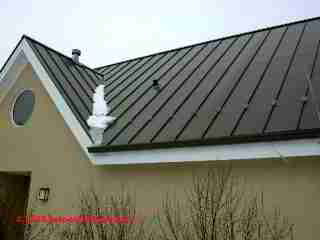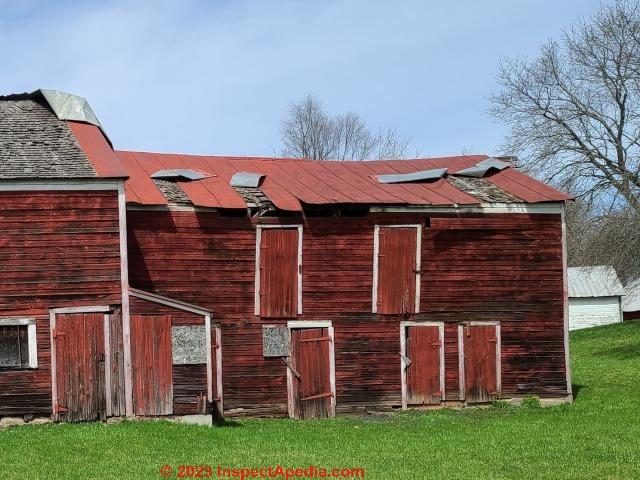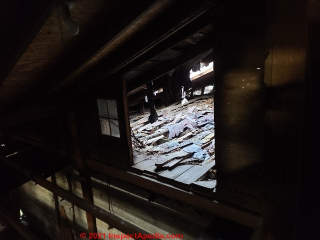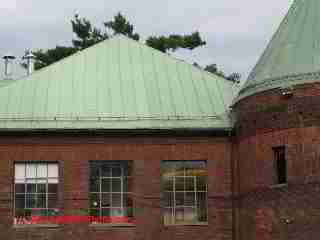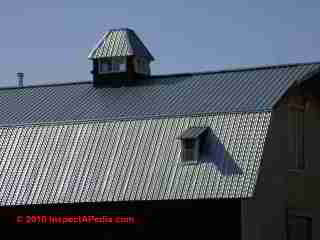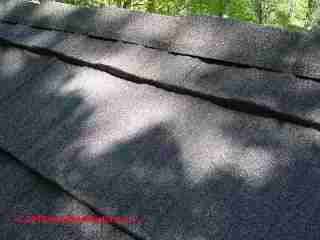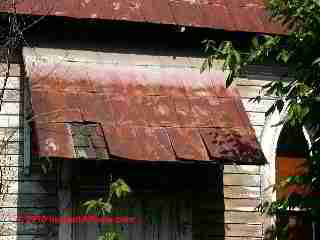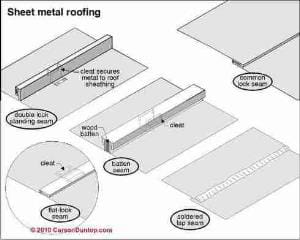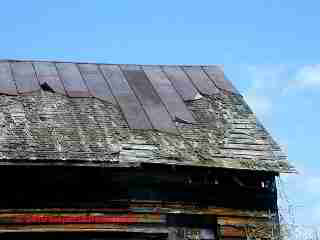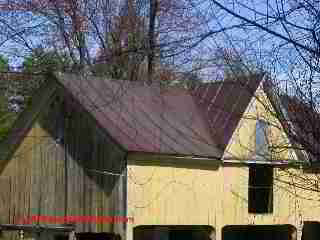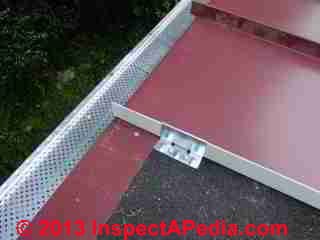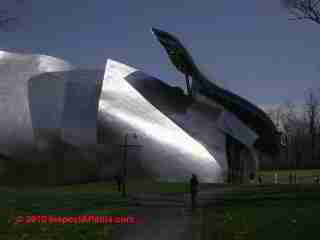 Metal Roofing Types, Product Sources, Installation, Defects, Repairs
Metal Roofing Types, Product Sources, Installation, Defects, Repairs
- POST a QUESTION or COMMENT about all types of metal roofing
This article describes each of the various types of metal roofing products and includes links to more details about each of those, including metal roof choices or types, installation methods, inspection, troubleshooting & metal roof repair procedures..
Page top photo by Daniel Friedman,showing the Richard B. Fisher Center for the Performing Arts at Bard College, New York, architect Frank Gehry.
InspectAPedia tolerates no conflicts of interest. We have no relationship with advertisers, products, or services discussed at this website.
- Daniel Friedman, Publisher/Editor/Author - See WHO ARE WE?
Metal Roofing Materials, Choices, Costs, Life Expectancy, Characteristics
 Residential installations of metal roofing have more than
doubled in the past several years, and they are now estimated
to account for over 10% of residential roofs.
Residential installations of metal roofing have more than
doubled in the past several years, and they are now estimated
to account for over 10% of residential roofs.
Originally associated with agricultural and commercial buildings, new metal roofing products aimed at the residential market are designed with simplified installation systems and offer more choices in materials, finishes, and design.
This introduction to metal roofing includes brief excerpts adapted with permission from Best Practices Guide to Residential Construction, chapter on BEST ROOFING PRACTICES.
Article Contents
General Properties of Metal Roofs
- Cost of Metal Roofs
The installed cost of premium metal roofing is three to four times more than asphalt shingles, but metal roofing offers a variety of attractive benefits: - Fire resistance of metal roofs:
Many metal roofs carry a Class A fire rating.
Watch out: do not install metal roofing over one or more existing layers of asphalt roofing without first checking with your local building department to see if that is permitted. In some building code jurisdictions, before installing metal roofing, removal of all layers of existing roof covering may be required. - Energy efficiency of metal roofs:
In a test conducted by the Florida Solar Energy Center, white metal roofing showed the greatest reductions in cooling loads of all roofing types, with 23 to 30% savings (compared to a control home with dark asphalt shingles). - Impact resistance of metal roofs:
Metal roofing systems offer moderate to excellent resistance to impact from hail, some earning UL’s Class 4 rating. Mold-resistant: Metal roofing resists the type of algae and mildew growth that attacks asphalt and wood roofs. - Life Expectancy of metal roofs?
Metal roofs typically carry a 30-to 50-year warranty. - Noise Transmission of Metal Roofs
One frequently cited disadvantage of metal roofing is that it generates a noticeable noise when struck by rain, hail, or even dropping acorns.
If installed directly to purlins with no roof sheathing, the noise might be heard in the building interior. However, when installed over a solid substrate, with normal levels of insulation, the noise should not be noticeably different than with other roofing types.
Details about roof noise transmission are
- Recycled content of metal roofs:
Many metal roofing products use recycled material, ranging from 25% with some steel products to over 90% with some aluminum modular shingles. - Walkability of Metal Roofs
Panels laid flat on solid decking are generally walkable. However, if panels are installed on battens, workers should be careful to step directly over battens or to use planking that spans multiple battens.
Modular shingle panels generally use fairly light-gauge material, but it is stiffened somewhat by the stamped textures. In general, modular steel panels are walkable, but aluminum ones should be reinforced by foam inserts in sections expected to see a lot of foot traffic.
Also see ROOF SLOPE OR ROOF PITCH DEFINITIONS - Weight of metal roofs:
Most metal roofing products range from 125 to 175 pounds per square. Some lightweight aluminum shingles weigh as little as 40 pounds per square. - Wind resistance of metal roofs:
Many systems have earned a Class 90 wind-uplift rating, UL’s highest rating.
...
Index to Metal Roof System Information
There are three general types of residential metal roofing
- Exposed-fastener Panel Metal Roofs - detailed
at METAL ROOF EXPOSED FASTENER SYSTEM,
also see CORRUGATED ROOFING - Standing-Seam Metal Roofs -
see STANDING SEAM METAL ROOF INSTALLATION
- Modular Panel Metal roofs. Details about metal shingle roofs of this type are
at MODULAR METAL ROOF SHINGLE SYSTEM.
Also see METAL SHINGLE ROOFS
As summarized in Best Practices Guide to Residential Construction, chapter on BEST ROOFING PRACTICES, all coated steel materials, however, are vulnerable to corrosion at field-cut edges
— although Galvalume® is the least affected Table 2-10 [image below] below lists the advantages, drawbacks, compatibility, and life expectancy of galvanized steel roofing, aluminized steel roofing, galvalume, aluminum, copper, and zinc metal roofing products.
[Click any table or image to see an enlarged version.]
Following this table is our complete list of metal roofing products.
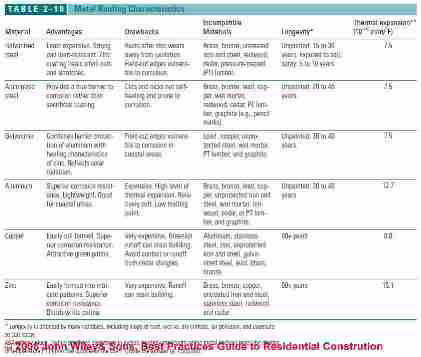
- Aluminum metal roofing,
first used in the U.S. in 1890 on Philadelphia's City Hall, difficult to solder, relied on mechanical joints and slope to shed water.
Details about aluminum roofing are
at ALUMINUM ROOFING.
Also see ALUMINUM METAL ROOFING - PRODUCT SOURCES
and ALUMINUM METAL ROOFING SYSTEM PROPERTIES
and CORRUGATED ROOFING - Aluminized Steel Roofing -
see details about aluminized steel roof coverings
at ALUMINIZED STEEL ROOFS - Barn Roofing -
is a synonym for exposed fastener metal roofs of aluminum or galvanized steel. Sometimes we find this roofing system used on residential properties too, though there are some questions about leak resistance of some installations.
Details are at BARN ROOFING, METAL.
and CORRUGATED ROOFING
Also see STEEL & IRON BUILDING SIDING - Copper metal roofing
an early use in the U.S. in 1764 on the New York City Hall, infrequently used until late 1800's when copper supply increased, more costly, easily worked, does not need a weather-resistant coating.
Details about copper roofing are
at COPPER ROOFING - Corrugated metal roofing
details of iron & steel metal corrugated roofs as well as other corrugated roofing products are
at CORRUGATED METAL ROOFING
See the history of these materials
at STEEL & IRON BUILDING SIDING
- Enameled steel roofing -
according to the US NPS, "Enameled steel as a building component came to this country by way of Germany at the end of the 19th century. Shingles of enameled steel were exhibited by a German industrialist at the 1893 World's Columbian Exposition.
The first American production was in 1924 by the Columbian Enameling and Stamping Company, which roofed a house in Terra Haute, Indiana, with enameled shingles.
Commercial markets developed by 1930, and enameled shingles became popular for use on service stations and chain restaurants. Except for the 2500 Lustron houses manufactured in the late 1940s, the material was rarely used in residential applications."
The NPS article includes an example from the 1929 Sweet's Architectural catalogue that describes enameled roof shingles. - Galvanized iron or steel roofing -
according to the US NPS, "Iron or steel are galvanized by coating them with zinc.
Rather than producing the simple coating created by tinplating, a rust resistant alloy of the two metals forms on the surface. In 1839, two years after galvanizing was patented in Europe, the material was used on the roof of the Merchants Exchange in Manhattan.
Details about galvanized iron or steel roofing are
at GALVANIZED STEEL ROOFS.
Also see GALVANIC SCALE & METAL CORROSION - Galvalume®
is metal roofing coated with zinc or zinc/aluminum. Details are
at GALVALUME METAL ROOFING - Iron and steel roofing -
according to the US NPS, "Both iron and steel without any plating were used for roofing.
The Philadelphia home of the mill owner who rolled the first sheet iron in the United States was roofed in the material around 1794.
Iron replaced slate on the White House in 1804. Because it was available in large sheets, rather than the small sheets used for plated material, it required fewer joints. Some manufacturers produced factory painted material, but late19th century accounts indicate that paint was an inadequate defense against the corrosive effects of the atmosphere in industrial regions." - Lead Roofing -
according to the US NPS, "The earliest use of lead for roofing in this country may have been at Rosewell, an 18th-century plantation house at Whitemarsh, Virginia.
Lead was widely used before the American Revolution for flashings, downspouts and gutters on the best buildings. In the United States, lead never achieved the popularity it had in Europe.
Installed on early Federal buildings in Washington, D.C., it failed to perform well. Expansion and contraction due to temperature changes produced fatigue, and on steep roofs the effect of gravity caused creep. In the 20th century lead found additional application as a coating for both steel and copper." - Lead-coated copper -
availble and used in construction since approximately 1900, lead-coated copper does not extend the life of copper itself, rather it provides an alternative color to architectural copper applications and it avoids staining that may occur on some light colored building surfaces (masonry, limestone, stucco, light-colored wood surfaces) where copper is used for roofing, flashing, or gutters.
Watch out for possible environmental concerns with lead runoff and lead exposure hazards.
Details about lead in roofing are
at LEAD ROOFING & FLASHING. - Stainless steel metal roofing
including terne-coated (tin and zinc-coated 304 stainless steel) roof materials. Details about stainless steel roofing are
at STAINLESS STEEL ROOFS - Steel metal roofing
includes
GALVANIZED STEEL ROOFS
and
GALVALUME METAL ROOFING discussed in those articles. - TERNE METAL ROOFING, or Terne II
coated metal roofing are used where copper roof runoff or corrosion are special concerns.
Terne coated stainless steel roof panels (Terne coating is a a zinc-tin alloy metal coating process that gives extra corrosion resistance. Other terne coatings using lead can present an environmental contamination worry from lead leachate found in roof runoff.)[1]
Details about terne metals used on roofs, gutters, and for other building exterior components are
at TERNE METAL ROOFING - ZINC METAL ROOFS -
according to the US NPS, "Rolled sheet zinc appeared in the United States in 1816, as roofing in New York and as downspouts and gutters in Baltimore.
Though more than seventy houses in New York had zinc roofs by 1837, it was out of favor by 1840. The popularity of the material was cyclical in the next decades, never matching iron and steel with their various coatings."
Zinc roofs are similar to copper in their durability and also similar to copper roofs in their installation procedures. But unlike copper, zinc roofs weather to a bluish-white color rather than green. Zinc roofing material, widely used in Europe, is very malleable and can be formed into intricate patterns for metal shingles
The American Galvanizers Association explains why Zinc works well as a corrosion resistive coating:
Zinc, like all metals, corrodes when exposed to the atmosphere. However, because of its ability to form dense, adherent corrosion byproducts, the rate of corrosion is considerably lower than ferrous materials (10 to 100 times slower depending on the environment).
Zinc corrosion products develop naturally on the surface as the coating is exposed to natural wet and dry cycles in the atmosphere and are often referred to as the zinc patina. The zinc patina acts as an additional barrier between the steel and the environment. In addition to the natural barrier protection of the coating and patina, zinc also protects the base steel cathodically. - American Galvanizers Association, retrieved 20 April 2015 - cited in page bottom References or Citations
This same AGA source points out that there are at least seven different types of coated or corrosion-resistant sheet metal products in current production:
- Galvanized (zinc or Zn-coated)
- Galvannealed (90-92% zinc / 8-10% iron alloy),
- AL-ZN alloy: 55% aluminum / 45% zinc
- AL-Zn alloy: 95% zinc / 5% aluminum
- Aluminum 100% aluminum
- Aluminum based alloy: 89-95% aluminum / 5-11% silicon alloy
- Terne coating (85-97% lead/3-15% tin alloy)
Properly installed zinc roofs have a life expectancy of as much as 100 years. Factors that affect the wear and life of a zinc metal roof include: Installation zinc roofing over solid roof decking (not spaced nailers)
Avoid exposure of zinc roof coverings to acids found in some plywood roof decks
(review ROOFING UNDERLAYMENT BEST PRACTICES) or use zinc roofing products with a protective coating on the underside of the material Use a ventilating mat between the zinc roof covering and the roof deck
- see our discussion of Enkamat underlayment ventilating plastic roof underlayment
at ROOF NOISE TRANSMISSION
Also see METALS USED IN ROOFING.
Factors Affecting Metal Roof Life and Leak Resistance
According to the US NPS,
Metal roofs have a long history of use, although improvements have occurred in shop fabrication methods and new sealant materials.
Metal roofs are available in a wide variety of rib configurations, colors, and slope configurations. Architectural systems use an underlying deck to provide structural support, while structural standing seam metal roofs provides an integral supporting frame.
Structural systems can be used to retrofit an existing flat roof deck to provide improved drainage. Sealant is required at valleys, gutters, and drains, to ensure water tightness.
- Workmanship of the metal roof installation, including consideration for thermal and building-related movement in the roof system
- Metal roof fasteners and connectors: proper selection and installation
- Metal roof joints, proper design and installation to accommodate movement and thermal changes
- Choice of metal, and exposure to particular environments: salt spray, chemicals from nearby factories, high winds, other weather conditions. For example
at ZINC METAL ROOFING we note that in Europe some zinc roofs are expected to last 100 years. - Roof slope can affect leak resistance and life on any roofing system. Installing a conventional standing seam or modular panel metal roof on a nearly flat surface is likely to lead to leaks.
Minimum Slope Requirement for Metal Roofs
Most metal roofing systems can be installed on slopes of 3:12 and greater and standing-seam systems from 2:12 and greater.
Special standing-seam systems
designed for slopes as shallow as
1/2 :12 require field
crimping machinery and have sealant in all seams. The
height of the ribs at seams and whether they are protected
with a sealant affect how weather tight a roof will be under
extreme weather. More on roof slopes is
at ROOF SLOPE DEFINITIONS.
Barn Roofing - Standing Seam or Exposed Fastener Metal Panel Roofs
Below we provide photos of both curved and straight traditional metal barn roofing. Also see corrugated roofing and standing seam roofing below.
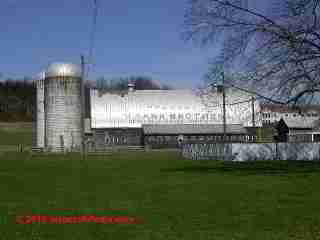
Barn Roofing?
Our friend, builder, and home inspector Steve Vermilye pointed out that "barn roofing" works fine on barns where ventilation is important and a few drops of water falling on a cow are harmless.
But when we find this low-profile corrugated roofing with simple nailed seams installed over a home where occupants expect to stay dry, we are not so sure this is the best option, even if it is one of low cost.
Watch out: as we illustrate in the photo below, metal roofing that is not adequately-secured at the roof edges will eventually be ripped from the roof by storm-winds.
This post and beam barn, built in Poughkeepsie, New York before 1900, demonstrates that a building can stand for a very long time provided it is protected from the weather by a good roof.
But once that roof protection is lost the building has not much remaining life. The original wood shingle roof, when worn and leaky, was covered by a light-weight standing seam metal roof.
More-recently storms have torn off a substantial part of the barn's metal roofing.
Below: post and beam details found in the same building (below) give an indication of the probable age of this New York barn when photographed in December 2021 and again in the spring of 2022 (above).
Openings through the roof admitting the weather will speed the fall of this magnificent building if the roof is not replaced.
See METAL ROOF EXPOSED FASTENER SYSTEM for details about barn roofing material, installation, fasteners, and for barn roof flashing
see METAL ROOF EXPOSED FASTENER FLASHING.
At CORRUGATED ROOFING we discuss all types of corrugated roofing products: metal and others.
Copper Roofs
The standing seam copper roof shown below protects Ely Hall, originally the Alumnae Gymnasium, William M. Tubby, architect, 1889, Vassar College, Poughkeepsie NY.
Examples of fastening details for the installation of copper roofs to the building roof deck or structure are discussed under metal and standing seam roofing below.
See COPPER ROOFING for details about antique and modern copper roofing products.
Also see COPPER SHINGLE METAL ROOFING - soldered metal or copper shingle roofing on flat or low-slope roofs.
Corrugated Metal Roofing
The patched corrugated metal roofing shown below (left) covers a pre-1900 home currently used as a parsonage in Dover Plains, NY. The modern corrugated roofing shown at right tops a gambrel-roofed barn in New England. More on roof shapes and architecture is
at ARCHITECTURE & BUILDING COMPONENT ID.

At CORRUGATED ROOFING we discuss all types of corrugated roofing products: metal and others.
Metal Shingle Roofs
The metal roof shingles at below-right found on a New York home are steel, coated with a granular material that from the ground can be mistaken for asphalt.
Carson Dunlop Associates' metal roof shingle sketch (below left) provides additional details about this roofing option.
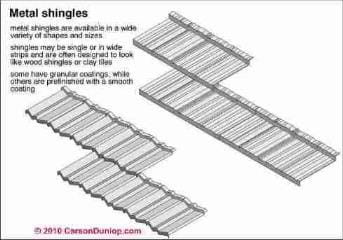
Details about metal shingle roofs of this type are
at MODULAR METAL ROOF SHINGLE SYSTEM.
Metal Shingle Roofs, Embossed, Antique
The antique embossed metal shingles (below) are found on the Justin Morrill Smith historic homestead, Vermont.
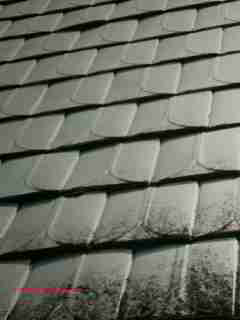 ...
...
Below we see an example of a metal roof in good condition.
In contrast, below we show metal roofs in more questionable shape, beginning with a metal shingled roof on a 1910 home in Rockland County, New York, courtesy of home inspector Dovber Kahn.
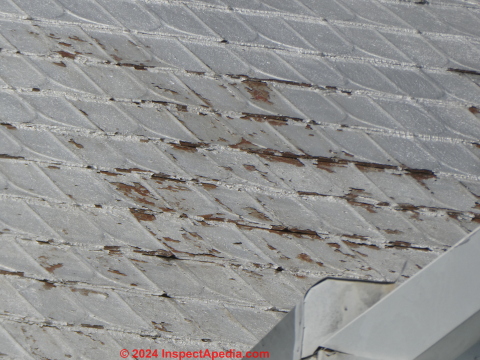
Above: these shingles are separating at some of their crimp joints, risking leaks, particularly in conditions of wind-driven rain or perhaps when water backs up the roof as accumulated snow begins to melt. We also see that the roof is rusting. But before cleaning and re-painting this roof we'd suggest that an experienced metal shingle roof contractor inspect its condition to be sure that the roof is salvageable.
Mr. Kahn is a licensed home inspector in New York and New Jersey, and can be reached at Website: Kahnbhomeinspectors, Tel: 845-445-8234, Email: kdovber@googlemail.com
Watch out: it can be a serious mistake to hire a roofing contractor to inspect a roof type with which she is not very familiar. Too often the contractor is tempted to err on the safe (for them) side: condemning the roof and advising that the owner install a new and different roof covering of the sort that the contractor uses. Before doing that let's be sure that the existing roof really deserves to be condemned.
The rusted metal shingles on the church roof (Clintondale, NY) shown in our photo below demonstrate more about the history of how metal roofing was used in the U.S.
We see that the original wood shingle roof was re-roofed using metal shingles.
Quoting Grapevine Design Guidelines:
Metal roofing in America is principally a 19th-century phenomenon. Before then the only metals commonly used were lead and copper.
Tin-plate iron, commonly called "tin roofing," was used extensively in Canada in the 18th century, but was not commonly used in the United States until rolling mills were established in this country. The low cost, light weight, low maintenance and ease of shipping of tin plate made it a common roofing material.
Embossed tin shingles, whose Grapevine Design Guidelines – Roof Design Guidelines
4.9 - 2 surfaces created interesting patterns, were popular throughout the country in the late 19th century. Tin roofs were often kept well-painted in red or green to imitate the green patina of copper. Unfortunately, few of these roofs remain intact today.
Similar snap-together metal roof shingles made of copper are discussed just below and also at patents described
in this article: COPPER SHINGLE METAL ROOFING - soldered metal or copper shingle roofing on flat or low-slope roofs.
Also see MODULAR METAL ROOF SHINGLE SYSTEM.
Soldered Flat Shingle and Flat Copper Metal Roofs
Flat metal shingles with interlocking edges were produced in both steel and copper, then soldered when in place.
Usually we find these installed on flat or low-slope roofs such as at dormer insets on homes constructed in the U.S. before 1900, often in the mid to later 1800s, but on occasion even on new or newly restored homes as well.
Carson Dunlop Associates' standing seam metal roof sketch (below) includes a sketch of soldering used to connect flat metal roofing panels.
Watch out: large expanses of metal roofing with soldered connections may flex and break open the soldered joints due to thermal movement.
Details about soldered copper roofs and some suggested inspection points are
at COPPER SHINGLE METAL ROOFING - soldered metal or copper shingle roofing on flat or low-slope roofs.
Standing Seam Metal Roofs
Standing seam metal roofs were widely used throughout North America and in modern forms remain in use today as a very durable roof covering, especially if the metal coating or paint is maintained.
Carson Dunlop Associates' standing seam metal roof sketch (left) shows how sheet metal roofing is secured to the roof deck using cleats. Sections of metal roofing may be joined by
- Standing seams that are rolled and crimped
- Interlocking seams
- Battened seams
- Soldered Joints or soldered lap seams
- Flat locking metal seams.
See STANDING SEAM METAL ROOF Installation for details about standing seam roof installation, flashing, maintenance, repair.
Our rusted standing seam barn roof photo (below left) demonstrates a common roofing sequence history: metal roofs were installed over worn-out wood shingle roofs as a more economical way to re-roof the building.
A second rusted standing seam barn roof is at below right, and our third standing-seam photo below shows a modern coated standing seam roof on North Henderson, the computing facility at Bard College, Annandale, NY.
Recommended distance between seams on a standing seam metal roof
Reader question: First, thank you for your excellent site. A great example of what makes up for the crappy stuff that draws so much criticism. This is for Vermont, where our 40 by 50 Seventies ranch house needs a new roof.
We were thinking of going from asphalt to standing seam, though it's not a highly pitched roof and the studs are 20 inches on center. Is there a recommended distance between the seams for a house like that, in a northern climate that sometimes sees heavy snowfall sometimes made heavier by subsequent rain?
Reply: Seam height vs. pitch on standing seam roofs
The spec for metal roofing seam distances is not about the horizontal distance between seams - that's pretty standard and up to the manufacturer.
But the seam height above the roof surface is of interest on lower slope roofs if we want to be sure the roof won't leak. You'll see Eric's hand and mine in the photo at below left, and a standing seam metal roof clip installed to the decking at below right.
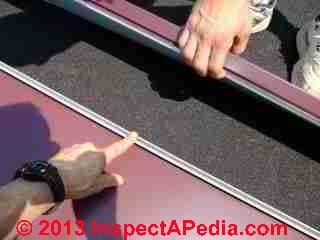
You want to discuss the slope of the roof with the roofing supplier.
For the metal roof we installed atop my office/lab a few years ago, as the slope was rather low (less than 4/12) we were assured that a standing seam roof would work perfectly well (New York) provided we installed one that had taller seams. I.e. taller, not closer together, on lower slopes.
The metal roof is secured not to the rafters but to the roof decking which itself is secured to the rafters. As you may have seen, the connection of roof to deck is by clips that mount over a seam and are screwed to the deck. Then the clip is covered by the next overlapping seam cap of the next section.
That's why rafter spacing shouldn't be an issue.
Also as a metal roof is typically lighter than most other options (asphalt for example) the rafter spacing should be less of an issue than before - with respect to the weight of the roof.
See STANDING SEAM METAL ROOF INSTALLATION for details about standing seam roof installation, flashing, maintenance, repair.
...
Metal Roofing History, Manuals, Sources, Products, & Manufacturers
Best Practices Guide to Residential Construction listed producers and sources of metal roofing, metal roof fastening systems, and related metal roofing products to which we add additional resources.
- American Galvanizers Association, "Zinc Coatings, A comparative analysis of process and performance characteristics", American Galvanizers Association, 6881 S. Holly Circle, Suite 108 Centennial, CO 80112 720-554-0900 | 800-468-7732 aga@galvanizeit.org www.galvanizeit.org
- Architectural elements: the technological revolution: Galvanized iron roof plates and corrugated sheets; cast iron facades, columns, door and window caps, ... (American historical catalog collection), Diana S Waite, available used out of Amazon.
- ASC Profiles Inc., LIGHT GAUGE METAL ROOF & WALL PANELS INSTALLATION GUIDE [PDF] (2019) ASC Profiles LLC, 2110 Enterprise Boulevard West Sacramento, CA 95691 USA, Website: www.ascbp.com retrieved 2021/03/02 original source: https://www.ascbp.com/files/BR128_LtGaugeInstall.pdf
- Atas International, website: www.atas.com - Modular metal shingle, tile, and standing-seam panels
- BMRD BUY METAL ROOFING DIRECT MANUAL [PDF] installation details and care & maintenance details for most types of metal roofing
- Best Buy Metals STANDING SEAM [ROOFING] INSTALL GUIDE [PDF] Best Buy Metals, 1652 S Lee Hwy, Cleveland, TN 37311 USA Tel: 800-728-4010, Email: info@bestbuymetals.com Website: bestbuymetals.com Metal roofing installation details, Best Buy Metals,
- Central States Manufacturing, HORIZON-LOC™ METAL ROOF INSTALLATION DETAILS [PDF] (2018) Central States Manufacturing Co., Metal building components, Email: info@centralstatesmfg.com Website: www.CentralStatesMfg.com retrieved 2019/09/11 original source: http://www.centralstatesmfg.com/wp-content/uploads/GUID_INSTL_HorizonLoc.pdf
- Classic Products, website: www.classicroof.com - Modular metal shingle panels and standing seam panels
- COPPER ROOFING
- COPPER SHINGLE METAL ROOFING
- Copper Roofing, Master specifications for copper roofing and sheet metal work in building construction: Institutional, commercial, industrial, I.E. Anderson, 1961 (hard to find)
- Corrugated Iron, Building on the Frontier, Simon Holloway
- Custom-Bilt Metals, website: www.custombiltmetals.com - Modular metal shakes and standing seam panels
- Decra Roofing Systems, website: www.decra.com - Modular metal shingle, tile, and shake panels
- Dura-Lok Roofing Systems, website: www.duraloc.com - Modular metal roofing shingles with granular coating
- Fabral,Headquarters: Lancaster Plant: 3449 Hempland Road, Lancaster, PA 17601 USA Tel: (800)477-2741 website: www.fabral.com Exposed fastener and concealed clip metal roofing panels
Fabral 5 RIB METAL ROOFING SYSTEM ORDERING & INSTALLATION GUIDE [PDF] (from Lowes.com 2021/03/02)N - [1] Follansbee Roofing, Follansbee WV 26037, Tel: 800-624-6906, website: www.follansbeeroofing.com and follansbeeroofing.com/products/TerneII.aspx Quoting Follansbee on TerneII properties:
Follansbee Steel is the only manufacturer of a pre-painted or natural Terne roof and is a leading supplier of metal roofs for new and retrofit commercial, institutional, residential and historic preservation projects.
Terne II - Classic Terne-Coated Steel ... is a new and improved version of historic Terne metal, ... Terne II has improved capability for resisting corrosion in all environments ... also has excellent formability, solderability, and affinity for paint ... without compromising mechanical characteristics. It can be used in flatlock, standing seam, vertical wall designs and virtually any other application in which original Terne has been used. It is strong and ductile, having high yield and tensile strengths as well as workability. This new material can easily be formed with conventional roofing tools.
With Terne II roofing, it is advisable to paint the material as soon as conditions permit. Oxide formation is slower than with the original Terne and the wait for proper painting conditions provides substantially less risk. The new material is coated with Follansbee's new ZT® alloy, a combination of zinc and tin. This coating is designed not only as a barrier but also to be anodic to the steel substrate and reduce the potential for oxidation before painting.
The traditional oil-based paints long required on original Terne are not recommended for application on Terne II. Follansbee's Rapidri paint with its faster drying time and ease of application is much superior to the old painting system. The Rapidri acrylic paints are aesthetically pleasing while offering enhanced durability and color retention. - Metal Experts, METAL ROOF INSTALLATION INSTRUCTIONS, 36" PANELS [PDF] (2013) - Metal Experts Roofing & Siding, retrieved 2023/12/16, original source: https://www.metalexperts.ca/pdf/InstallationGuide.pdf
- Metal Roofing Alliance, E. 4142 Hwy 302, Belfair, WA 98528, Telephone:(360) 275-6164, Customer Support 410-534-6900, Email: support@metalroofing.com,
Website: www.metalroofing.com. Quoting:
The Metal Roofing Alliance was formed in 1998 by a small group of forward-thinking metal roofing manufacturers with the main goal of educating consumers about the many benefits of metal roofing. - The Metal Initiative, 4700 W. Lake Ave., Glenview, IL 60025, P:847.375.4785 Website: www.themetalinitiative.com/, Email: Louise Ristau lristau@connect2amc.com Quoting:
The Metal Initiative is a coalition of manufacturers, individuals and associations that have come together to provide information on the features and benefits of metal in construction.
Carrying its message of metal primarily to the professional building owner community, The Metal Initiative seeks to gather and disseminate useful information for decision-makers. - Metal Roofing, an Illustrated Guide, R.A. Knowlton , [metal shingle roofs],
- Gerard Roofing Technologies, website: www.gerardusa.com - Modular metal shake and tile panels with granular coating
- MCA METAL ROOFING INSTALLATION MANUAL [PDF] Metal Construction Associaiton 8735 W. Higgins Rd., Suite 300, Chicago IL 60631 USA, Tel: 847-375-4718 Email: mca@metalconstruction.org Website: www.metalconstruction.org retrieved 2021/03/02
- ME 36" METAL ROFING PANEL INSTALLATION INSTRUCTIONS [PDF] (2013) Metal Experts Roofing & Siding
- Met-Tile, website:www.met-tile.com, Modular metal roof-tile panels
- MRA, Metal Roofing Alliance, PO Box 2799, Longview, WA 98632 USA, Customer Support (410) 534-6900 General Email Inquiries support@metalroofing.com Website: www.metalroofing.com
- Metal Sales Manufacturing Corp., CLASSIC RIB METAL ROOF INSTALLATION GUIDE [PDF] Locations across the U.S.A., TECHNICAL SERVICES 545 South 3rd Street, Suite 200 Louisville, KY 40202 USA 502.855.4300 Tel: 800.406.7387 Toll Free retrieved 2019/09/11 original source https://www.metalsales.us.com/system/files/resources/installation-guides/classic-rib-installation-guide8-2016.pdf
- NRCA, Smith, Thomas L., AIA, CRC, METAL ROOFING: 'FIXING' FOR THERMAL MOVEMENT [PDF] Professional Roofing, [date pending] p. 72, NRCA - Web: http://www.nrca.net/
- NRCA, Smith, Thomas L., AIA, CRC, METAL ROOF SYSTEMS: DESIGN CONSIDERATIONS FOR SNOW AND ICE [PDF] Professional Roofing, [date pending] p. 74, NRCA, http://www.nrca.net/
- NRCA, Smith, Thomas L., AIA, CRC, THE MANY ASPECTS of METAL [ROOF] SHINGLES [PDF] Professional Roofing, [date pending] NRCA, Web: nrca.net
- NRCA, Smith, Thomas L., AIA, CRC, STEEL [ROOF] DECK CORROSION BULLETIN [PDF] Professional Roofing, [date pending] p. 58, NRCA, http://www.nrca.net/
- NRCA, Smith, Thomas L., AIA, CRC, STEEL [ROOF] DECK ISSUES for the 1990s [PDF], NRCA, http://www.nrca.net/
- NPS, METALS in AMERICA'S HISTORIC BUILDINGS [PDF] (1992) National Park Service, U.S. Department of the Interior,
Part I. A Historical Survey of Metals, by Margot Gayle and David W. Look, AlA
Part II. Deterioration and Methods of Preserving Metals by John G. Waite, AlA - NPS, FROM ASBESTOS TO ZINC, ROOFING FOR HISTORIC BUILDINGS, METALS [PDF] chnical Preservation Services, National Park Service, U.S. Department of the Interior, web search 9/29/2010, original source: nps.gov/history/hps/tps/roofingexhibit/metals2.htm
- NPS, FROM ASBESTOS TO ZINC, ROOFING FOR HISTORIC BUILDINGS, METALS-PART II, Coated Ferrous Metals: Iron, Lead, Zinc, Tin, Terne, Galvanized, Enameled Roofs [PDF] Technical Preservation Services, National Park Service, U.S. Department of the Interior, web search 9/29/2010, original source: nps.gov/history/hps/tps/roofingexhibit/metals.htm
- NPS, FROM ASBESTOS TO ZINC, ROOFING FOR HISTORIC BUILDINGS, METALS- ROOFING TODAY [PDF] Technical Preservation Services, National Park Service, U.S. Department of the Interior, web search 9/29/2010, original source: nps.gov/history/hps/tps/roofingexhibit/roofingtoday.htm
- Park, Sharon C., AIA, THE USE OF SUBSTITUTE MATERIALS ON HISTORIC BUILDING EXTERIORS [PDF] Preservation Brief 16, Technical Preservation Services, National Park Service, U.S. Department of the Interior, web search 9./29.10, original source:
http://www.nps.gov/history/hps/tps/briefs/brief16.htm - Sentrigard, METAL ROOFING PANEL INSTALLATION INSTRUCTIONS [PDF] Sentrigard Metal Roofing Systems, retrieved 2023/12/16, original source: https://www.sentrigard.com/resources-files/Technical-Documents-Bulletins/Sentrigard-Installation-Instructions.pdf
- Sweetser, Sarah M., ROOFING for HISTORIC BUILDINGS [PDF] (1978) Preservation Brief 4, Technical Preservation Services, National Park Service, U.S. Department of the Interior, web search 9./29.10, original source: http://www.nps.gov/history/hps/tps/briefs/brief04.htm
- Terrabella® STONE COATED STEEL ROOF INSTALLATION MANUAL (shakes, shingles) [PDF] Terrabella® part of Alucom Group, Alucom LLC 2145 NW 115TH AVE. Miami, FL 33172 USA Technical Advisor Tel: (786) 651-4993 Fax: (305) 677-2232 Website: www.terrabellaroof.com retrieved 2019/09/11 original source http://www.terrabellaroof.com/wp-content/uploads/2015/02/Manual_Classic,_Shake_&_Single.pdf
- See more metal siding and roofing manufacturers and guides found
at STEEL & IRON BUILDING SIDING
...
Reader Comments, Questions & Answers About The Article Above
Below you will find questions and answers previously posted on this page at its page bottom reader comment box.
Reader Q&A - also see RECOMMENDED ARTICLES & FAQs
On 2018-11-14 by Paco - trailer home with bad metal roof?
Our metal roof has no underlayment, no air spacer.it isn't insulated. It drips condensation inside. We are colder in winter and now we bake in the summer.and it's a simple 65 ft trailerhome.no plywood. .was this a bad install.job?
On 2018-11-14 - by (mod) -
Paco
It sounds like an incomplete roof job; for most climates you want at the very least ceiling or under-roof insulation and a vapor barrier on the warm side of the insulation.
On 2016-08-11 by Jill - what roofing product to buy for a car port and pergola?
Hi can you help please? I need advise on what roofing product to buy for a car port and pergola? I am having the car port roof build in the same structure and the same galvanised wood as the pergola.
The pergola runs along the back of the garage and car port. I notice there are zinc, plastic coated steel and poly carbonate sheets.
Where we live is covered in trees and so everything goes green and I thought it may be best to have a green coloured roof product on both the car port and the pergola. Do you have any advice please? Kindest Regards Jill
On 2016-08-11 - by (mod) -
Jill
Galvanised - is a process used to reduce the rate of rust and corrosion on metal components, not wood materials. See GALVANIZED STEEL ROOFS https://inspectapedia.com/roof/Galvanized_Metal_Roofing.php for an example.
You might mean pressure treated wood - seeif that's what your pergola and car port are using as a wood structure.
You wont' find "galvanized wood" - that's a mix-up of terms.
If indeed you're planning to use a metal roof you will probably enjoy a dark-colored coated steel roof, black, or dark green, as the stains will show up less.Black will show stains the least but may be hotter than you want.
Indeed my read of the metal roof care instructions for the products I've used shows that the manufacturer warns that if you don't keep cleaning off the roof surface, leaves and organic debris will indeed discolor the roof and worse, accumulated debris left on the roof may lead to early corrosion and a shorter roof life.
My OPINION about the stain issue is that the level of risk depends on
- the proximity of trees or other sources of debris that may blow onto the roof
- the roof slope - steeper roofs drain faster and debris washes off more reasily
- the use of snow guards - that will catch debris and hold it on the roof
- ease of access to the roof for periodic cleaning
- and of course the manufacturer's instructions for metal roof maintenance for their specific product.
Watch out: some metal roofing systems that are to be installed atop treated wood or preservative treated wood may be corroded by interaction between the wood preservative and the metal roof product. Be sure to review this with your roofing manufacturer as they may require some additional installation details to assure a long roof life.
...
Continue reading at LIFE EXPECTANCY of METAL ROOFS or select a topic from the closely-related articles below, or see the complete ARTICLE INDEX.
Or see these
Recommended Articles
- METAL ROOFING - home
- ALUMINUM ROOFING
- ALUMINIZED STEEL METAL ROOFS
- BARN ROOFING, METAL
- COPPER ROOFING
- COPPER SHINGLE METAL ROOFING
- CORRUGATED METAL ROOFS
- ENAMELED STEEL ROOFS
- FLASHING for METAL ROOFS
- GALVALUME METAL ROOFS
- GALVANIC SCALE & METAL CORROSION
- GALVANIZED STEEL ROOFS
- LEAD ROOFING & FLASHING
- LIFE EXPECTANCY of METAL ROOFS
- METAL ROOF COATINGS & PAINTS
- METAL ROOF EXPOSED FASTENER SYSTEM
- METAL ROOF EXPOSED FASTENER SPACING
- METAL ROOFING SOURCES, MANUFACTURERS
- METAL SHINGLE ROOF, ANTIQUE EMBOSSED
- METAL SHINGLE ROOF MODULAR
- METALS USED IN ROOFING
- MODULAR METAL ROOF SHINGLE SYSTEM
- ROOF NOISE TRANSMISSION - reduce roof noise heard inside a building
- SNOW GUARDS on METAL ROOFS
- SOLDERED FLAT METAL & FLAT COPPER ROOF
- STAINLESS STEEL ROOFS
- STANDING SEAM METAL ROOF INSTALLATION
- TERNE METAL ROOFING
- ZINC METAL ROOFING
- NOISE CONTROL for ROOFS
- STEEL & IRON BUILDING SIDING
Suggested citation for this web page
METAL ROOFING at InspectApedia.com - online encyclopedia of building & environmental inspection, testing, diagnosis, repair, & problem prevention advice.
Or see this
INDEX to RELATED ARTICLES: ARTICLE INDEX to BUILDING ROOFING
Or use the SEARCH BOX found below to Ask a Question or Search InspectApedia
Ask a Question or Search InspectApedia
Try the search box just below, or if you prefer, post a question or comment in the Comments box below and we will respond promptly.
Search the InspectApedia website
Note: appearance of your Comment below may be delayed: if your comment contains an image, photograph, web link, or text that looks to the software as if it might be a web link, your posting will appear after it has been approved by a moderator. Apologies for the delay.
Only one image can be added per comment but you can post as many comments, and therefore images, as you like.
You will not receive a notification when a response to your question has been posted.
Please bookmark this page to make it easy for you to check back for our response.
IF above you see "Comment Form is loading comments..." then COMMENT BOX - countable.ca / bawkbox.com IS NOT WORKING.
In any case you are welcome to send an email directly to us at InspectApedia.com at editor@inspectApedia.com
We'll reply to you directly. Please help us help you by noting, in your email, the URL of the InspectApedia page where you wanted to comment.
Citations & References
In addition to any citations in the article above, a full list is available on request.
- Architectural elements: the technological revolution: Galvanized iron roof plates and corrugated sheets; cast iron facades, columns, door and window caps, ... (American historical catalog collection), Diana S Waite, available used out of Amazon.
- Copper Roofing, by CDA
- Kolle, Jefferson, Choosing Roofing," Jefferson Kolle, January 1995, No. 92, Fine Homebuilding, Taunton Press, 63 S. Main St., PO Box 5506, Newton CT 06470 - 800-888-8286 - see http://www.taunton.com/FineHomebuilding/ for the magazine's website and for subscription information.
- Problems in Roofing Design, B. Harrison McCampbell, Butterworth Heineman, 1991 ISBN 0-7506-9162-X (available used)
- Grapevine Design Guidelines - Web Search 07/12/2010
- NRCA - National Roofing Contractors Association, 10255 W. Higgins Road, Suite 600, Rosemont, IL 60018-5607, Tel: (847) 299-9070, Web: nrca.net
- Best Practices Guide to Residential Construction, by Steven Bliss. John Wiley & Sons, 2006. ISBN-10: 0471648361, ISBN-13: 978-0471648369, Hardcover: 320 pages, available from Amazon.com and also Wiley.com. See our book review of this publication.
- In addition to citations & references found in this article, see the research citations given at the end of the related articles found at our suggested
CONTINUE READING or RECOMMENDED ARTICLES.
- Carson, Dunlop & Associates Ltd., 120 Carlton Street Suite 407, Toronto ON M5A 4K2. Tel: (416) 964-9415 1-800-268-7070 Email: info@carsondunlop.com. Alan Carson is a past president of ASHI, the American Society of Home Inspectors.
Thanks to Alan Carson and Bob Dunlop, for permission for InspectAPedia to use text excerpts from The HOME REFERENCE BOOK - the Encyclopedia of Homes and to use illustrations from The ILLUSTRATED HOME .
Carson Dunlop Associates provides extensive home inspection education and report writing material. In gratitude we provide links to tsome Carson Dunlop Associates products and services.


